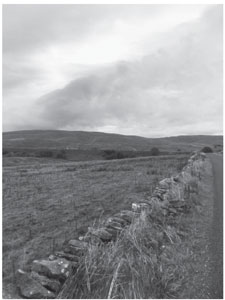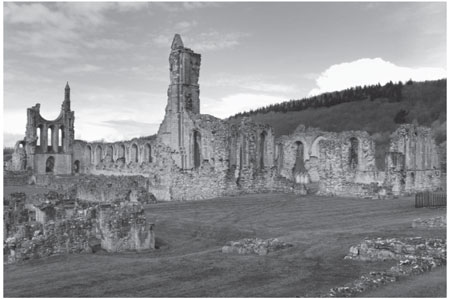Folklore of Yorkshire (20 page)
Read Folklore of Yorkshire Online
Authors: Kai Roberts


The road across Blea Moor, haunt of a treasure guarding hob. (Kathryn Wilson)
By the nineteenth century, when the majority of Yorkshire traditions concerning hobs and boggarts were recorded, it is likely that their origin as ancestral spirits had long since been consciously forgotten and only a vague, intuitive remembrance endured. As Katharine Briggs notes, unlike the Roman
Lares
and other household spirits of antiquity
,
British examples were not irrevocably tied to a particular building but seemed to come and go as they chose, conspicuously exercising their free will in the matter. Perhaps most significantly, however, they were no longer exclusively helpful guardian spirits, but had acquired their characteristic dual nature.
One hypothesis as to how this capricious and malevolent side had entered the household spirit tradition in Britain, is that it was a consequence of the Protestant Reformation in the sixteenth century. It seems likely that a belief in beneficial household spirits endured through the Middle Ages because, as Hilda Ellis Davidson notes, ‘After Christianity was set up, many concepts on a simple level, like those of the household guardian spirits, persisted because they were humble enough to escape condemnation, and also because they held a strong appeal for young and old.’ However, whilst Catholicism could comfortably live side-by-side with belief in such spirits because it was not a threat to their overall cosmology, this was not the case for Protestantism and especially not Puritanism.
Following the Reformation, theologians in England were especially keen to discourage any of the characteristically Catholic beliefs which they had so decisively rejected. Amongst them was the concept of Purgatory – a realm in which minor sinners were held and purified before being granted entrance to Heaven. For Catholics, earthbound spirits were souls who were unable to proceed straight to Heaven and existed in a purgatorial state. But because Protestants rejected the reality of Purgatory, it followed that they must also reject the reality of earthbound spirits. Accordingly, whilst they did not go as far as to deny that people
thought
they encountered such spirits, they redefined them as demons in disguise, and throughout the sixteenth and seventeenth centuries, Protestant polemicists churned out numerous tracts denouncing them.
It was, perhaps, this process of transformation that causes Katharine Briggs to observe, ‘The line between the devil and the hobgoblin is very lightly drawn. Often the same story is told about both, they behave in the same manner, and the same methods are necessary in dealing with them.’ However, whilst the notion of household spirits as demons eventually entered the collective consciousness, it seems that folk tradition also stubbornly cleaved to an older belief in their beneficence, no matter how contradictory that might seem. It is likely that this was especially true in the remoter areas of the northern counties of England, where vestiges of Catholicism clung on more tenaciously; and whilst we should always be wary of such neat explanations in folklore, this process may account for the dual nature ascribed to hobs and boggarts in Yorkshire.
In some instances, however, it is clear that such beings were conceived of primarily as demons. As previously noted, the term ‘boggart’ is more often applied to mischievous and downright vindictive tutelary spirits than ‘hob’, although it is not clear to what extent this was true of the folk tradition itself and to what extent it was the result of collectors’ artificial taxonomies. Nonetheless, some writers have suggested a putative linguistic root between the words ‘boggart’ and ‘bogeyman’ – a generic label applied to ‘any figure deliberately used to frighten others, almost always children, to control their behaviour.’
It is clear that some boggarts were conceived in such a fashion. For instance, the boggart that haunted Wibsey Slack near Bradford was described as ‘an exceedingly tall man with gigantic feet. His footfalls, which have been compared to the head of a steam-hammer, were said to reverberate through the whole neighbourhood.’ In the nineteenth century, Wibsey Slack was a ‘dreary stretch of bleak windswept waste’ and precisely the sort of place parents would discourage their children from going. The boggart of Bunting Nook near Sheffield seems to have performed a similar function. Bunting Nook was renowned as a desolate place, even in the twentieth century, and the noted Victorian folklorist S.O. Addy remarks that this boggart was ‘held up as a terror to children’.
Elsewhere, we find unique baleful tutelary spirits such as ‘Awd Goggie, who in the East Riding was said to haunt orchards, presumably in an effort to keep children from scrumping apples. Similarly, in Craven there is Churn Milk Peg, ‘a fearsome hag, whose only business in life apart from smoking a very dainty fairy-pipe, was to scare children when they bent on plucking unripe fruit from the hedgerow ... If the bairns were rash enough to disregard the warning, Churn Milk Peg carried them off forthwith to some dim abode where sun never shone and stars never twinkled.’
At Flamborough on the Holderness coast, a dangerous pit was reputedly the abode of Jenny Gallows and if a person circled the hollow a certain number of times, she would rise up and cry out:
Ah’ll tee on me bonnet
An’ put on me shoe
An’ if thoo’s not off
Ah’ll suan catch thoo!
According to local legend, a farmer once attempted the feat on horseback, whereupon Jenny Gallows appeared and pursued the reckless rider as far as the boundary of the village. She did not seem able to follow him beyond its threshold, but before he got away, ‘She bit a piece clean out of the horse’s flank and the old mare had a white patch there to her dying day.’
Every environment seems to have possessed its own characteristic bogeyman. The wild uplands of the Yorkshire Dales were haunted by the Brown Man of the Moors, described as a ‘dwarf, big-headed, wide of shoulders, with a shock of tousled hair and clothes russet as October’s brackens. He lies in wait for every traveller, challenging him to combat.’ Meanwhile, the urban streets of South Yorkshire were terrorised by a monster known as Jack-In-Irons. With some similarities to the Wibsey boggart, this entity was imagined as ‘a terribly strong man, gaunt, and at least ten feet high, with clanking chains at feet and wrists. He suddenly appears in quiet streets, or springs out of dark corners, in order to carry off the unwary pedestrian to unknown regions.’
As Steve Roud and Jacqueline Simpson cannily note, a bogeyman is ‘often the final function of a belief adults no longer share.’ This is certainly true of the hob and boggart today. Whilst the terms endure in toponyms and regional folk tale collections, it is now rarely used with any sincerity. Poltergeists have succeeded the idea of the malevolent boggart and are the province of parapsychological investigators, whilst the classic household spirit itself is relegated to the realm of children’s books and tourist lore. However, it is clear that they once represented an active, vibrant tradition across Yorkshire, stretching back many centuries. As J.C. Atkinson observed of one of his informants, ‘[She] told forth her tale as of things that had happened under everybody’s cognisance, and as might be only the other day; and of which she had only just missed personal cognisance herself by coming a little too late on the scene.’
G
HOSTS
![]()
I
n view of the variety of supernatural phenomena already covered in this book, there are at least two good reasons why the reader may ask why ghosts deserve a chapter to themselves. Firstly, to what extent do ghosts qualify as folklore? As the existence of such phenomena remains a moot point – in a recent survey, 38 per cent of the British population affirmed their belief in ghosts and 19 per cent claimed to have encountered one – it could be argued that to baldly define such belief as ‘folklore’ is begging the question. Accordingly, this chapter will only consider historical and ‘legendary’ ghosts – i.e. those spectres which exist as rumour alone – rather than first-hand accounts or memorates. Such an approach will illustrate how popular beliefs about ghosts have changed over the centuries to reflect the dominant religious, philosophical and cultural concerns of their age.
The second issue is whether it is fair to demarcate ‘ghosts’ as a class of phenomena distinct from the other supernatural entities in this book: is it possible to say, for instance, that a ghost is something different from a guytrash or boggart? It is true that such taxonomies may be rather arbitrary and imprecise. As Jacqueline Simpson notes, ‘Psychologically, any experience of the uncanny is understood through the belief system of the perceiver and his/her community. It may be experienced as an encounter with a ghost, a fairy, a demon or an alien from outer space – whatever seems plausible at that time and place.’ However, broadly speaking, a ghost can be characterised as the spirit of a potentially identifiable deceased individual that has returned to walk the material world, and this chapter will discuss belief that conforms to such a definition.
It can be argued that belief in ghosts as we understand them today arose in England around the thirteenth century, when the concept of Purgatory became orthodox theological doctrine. Prior to this point, the restless dead had typically been characterised as revenants – i.e. animated corpses possessed by the Devil, more closely resembling our modern idea of vampires or zombies. Writing around 1198, the Yorkshire monk William of Newburgh documents several examples of such belief in the county. Yet, approximately two centuries later, a collection of anecdotes concerning encounters with the dead, recorded by an anonymous monk of Byland Abbey, reveals tales of revenants to have been overtaken by narratives featuring visible but incorporeal spirits. Whilst these are credited with more agency than many ghosts, they are clear forerunners of the modern spectre.

Byland Abbey in North Yorkshire, where the earliest ghosts in the county were recorded. (Kai Roberts)
The notion of Purgatory as an intermediate realm in which the souls of minor sinners were purified before they could be received into Heaven, provided a conceptual framework by which the spirit of a departed individual could return to this world. Invariably, such spirits manifested to demand post-mortem absolution of sin and intercessory prayers, which could hasten the progress of a soul through Purgatory. A number of the stories recorded by the Byland monk ably illustrate this doctrine and it is thought they may have been preserved for use as exemplar in sermons, emphasising the importance of regular shriving and intercessory prayer in terms which an uneducated congregation might understand.
For instance, one story concerns the ghost of a monk of Newburgh Priory who during his life had been excommunicated for stealing some silver spoons. His spirit appeared to a ploughman and begged him to retrieve the spoons from where they had been hidden, take them to the Prior of Newburgh and ask him to absolve the monk’s sin. The ploughman followed these instructions and the ghost was able to rest in peace. Another tale involves an Ampleforth woman who had unjustly bequeathed her property to her brother instead of her husband and children, who had been evicted after her death. The woman’s ghost appeared to a local man and requested that he beseech her brother to give the land to her husband and sons, or else she could not rest. Her brother refused, so the woman appeared to him herself and told him that he too would know no peace when he died.